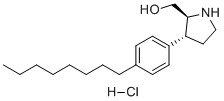| Cas No.: | 1841409-92-4 |
| Chemical Name: | Chembl4440140 |
| Synonyms: | Chembl4440140 |
| SMILES: | Cl.OC[C@H]1[C@H](C2C=CC(=CC=2)CCCCCCCC)CCN1 |
| Formula: | C19H32ClNO |
| M.Wt: | 325.916484832764 |
| Purity: | >97% |
| Sotrage: | 2 years -20°C Powder, 2 weeks 4°C in DMSO, 6 months -80°C in DMSO |
| Publication: | Simultaneous inhibition of endocytic recycling and lysosomal fusion sensitizes cells and tissues to oligonucleotide therapeutics-February 2023 Nucleic Acids Research DOI:10.1093/nar/gkad023 |
| Description: | SH-BC-893 is a water-soluble, orally bioavailable synthetic sphingolipid that triggers nutrient transporter internalization and also blocks lysosome-dependent nutrient generation pathways in cancer cells, activates protein phosphatase 2A (PP2A), leading to mislocalization of the lipid kinase PIKfyve; selectively kills cells expressing an activated form of the anabolic oncogene Ras in vitro and in vivo.SH-BC-893, increases the activity of antisense oligonucleotides (ASOs) and small interfering RNAs (siRNAs) up to 200-fold in vitro without permeabilizing endosomes. SH-BC-893 treatment trapped endocytosed oligonucleotides within extra-lysosomal compartments thought to be more permeable due to frequent membrane fission and fusion events. Simultaneous disruption of ARF6-dependent endocytic recycling and PIKfyve-dependent lysosomal fusion was necessary and sufficient for SH-BC-893 to increase non-lysosomal oligonucleotide levels and enhance their activity. In mice, oral administration of SH-BC-893 increased ASO potency in the liver by 15-fold without toxicity. More importantly, SH-BC-893 enabled target RNA knockdown in the CNS and lungs of mice treated subcutaneously with cholesterol-functionalized duplexed oligonucleotides or unmodified ASOs, respectively. Together, these results establish the feasibility of using a small molecule that disrupts endolysosomal trafficking to improve the activity of oligonucleotides in extrahepatic tissues. |
| References: | Simultaneous inhibition of endocytic recycling and lysosomal fusion sensitizes cells and tissues to oligonucleotide therapeutics-February 2023 Nucleic Acids Research DOI:10.1093/nar/gkad023 |

 DC Chemicals' products qualify for U.S. tariff exemptions. We guarantee no price increases due to customs duties and maintain stable supply, continuing to deliver reliable research solutions to our American clients.
DC Chemicals' products qualify for U.S. tariff exemptions. We guarantee no price increases due to customs duties and maintain stable supply, continuing to deliver reliable research solutions to our American clients.





















